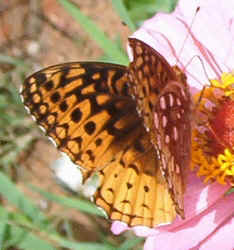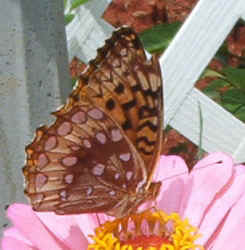 |
 |
Silver-Bordered Fritillary
Scientific Name: Clossiana selene
Family Name: Nymphalidae
Serendipity Ranch
Columbus, North Carolina
 |
 |
1 5/8 - 2 1/8 inch. Underside: Our only lesser fritillary with metallic silver spots on hindwing; submarginal spots are black. Early stages: Caterpillar mottled dark gray with pale yellow spines, except front thoracic pair black. Food: Violets. Flight: Late June - July (1 brood) in North, May or June - September (2 - 3 broods) in Eastern United States. Habitat: Wet meadows, marshes, or bogs. [Opler, Paul A. and Malikul, Vichai, Peterson Field Guides Eastern Butterflies, Houghton Mifflin Company, Boston, 1992]
Tawny-orange to ocherous above, with black lines and dashes and broken black rim. Below, orange forewing; orange-brown hindwing but 4 rows of metalic silver spots including a row on margin. Central silver cell spot below is elongated, submarginal dots dark. Life Cycle: Egg, 9/256 inch - 7/256 inch, cream-colored; laid on or near host plants, violets (Viola). Caterpillar, to 5/8 inch, brownish-black mottled with yellow and gray; has many yellowish branching spines; overwinters half grown. Chrysalis, to 1/2 inch, tan with brown and green patches. Flight: Up to 3 broods in East, Plains, and Northwest; May - September. 1 brood in Arctic and Rocky Mountains; June - August. Habitat: Moist meadows and bogs, often near woodlands or aspen scrub, sometimes wet meadows among plains or sagelands. Range: Alaska east to Neewfoundland, south to Oregon, New Mexico, Illinois, and North Carolina. Holarctic: also Europe and Asia. Information: The Silver-bordered Fritillary is the only lesser fritillary which has bright silver spots below. It approaches the size of the greater fritillaries (Speyeria) in the Midwest but is small elsewhere. In the East, this species is usually abundant in marshy meadows but northwestern colonies are widely scattered. One colony exists in a quaking bog in the arid Columbia Basin desert. Adults seek nectar from red clover, vervain, and other flowers during the morning, and court and mate shortly before sunset. [Pyle, Robert Michael, Audubon Society Field Guide to North American Butterflies, Alfred A. Knopf, New York, 1981]
Butterfly and Moth Home Page * Butterfly and Moth Books * Nature Lovers